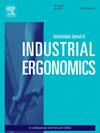The effects of cognitive load and task precision restrictions on trunk and shoulder kinematics in a manual material handling task
IF 3
2区 工程技术
Q2 ENGINEERING, INDUSTRIAL
International Journal of Industrial Ergonomics
Pub Date : 2025-08-15
DOI:10.1016/j.ergon.2025.103795
引用次数: 0
Abstract
This study examined how a concurrent mental task and precision restrictions affected the kinematics of the trunk and shoulder during a simulated lifting task. Musculoskeletal disorders in material handling operations are highly prevalent. In addition to completing physically demanding work, workers must also manage concurrent mental demands. Few studies have examined the effect of concurrent mental demands in occupationally relevant tasks. This study quantified the effects of varying degrees of cognitive loads and task precision demands on a material handling task by examining these effects on the kinematics of the trunk and shoulders. Eleven subjects lifted and placed a 5 kg box at one of three destination heights (low, middle, high) while performing a simultaneous cognitive task (no task, a simple task, a complex task) and under two precision conditions (low precision, high precision). The cognitive task consisted of time-based arithmetic questions at two levels of difficulty. The primary dependent measures were the angular velocities of the trunk and shoulders. Significant decreases in angular velocities for both higher cognitive load complexities and higher precision conditions were observed, which differed depending on the destination height. Overall, this study found that increased complexity of a simultaneous cognitive task and higher task precision requirements led to longer lift times and decreased joint velocities.
认知负荷和任务精度限制对人工搬运任务中躯干和肩部运动学的影响
本研究考察了在模拟举重任务中,并发的心理任务和精度限制如何影响躯干和肩部的运动学。材料搬运作业中的肌肉骨骼疾病非常普遍。除了完成体力要求高的工作外,员工还必须同时管理精神需求。很少有研究考察并行心理需求对职业相关任务的影响。本研究量化了不同程度的认知负荷和任务精度要求对材料搬运任务的影响,通过检查这些对躯干和肩部运动学的影响。11名受试者在同时执行认知任务(无任务、简单任务、复杂任务)和两种精度条件(低精度、高精度)时,将一个5公斤重的箱子举起并放置在三个目标高度(低、中、高)之一。认知任务包括两个难度等级的基于时间的算术问题。主要的依赖指标是躯干和肩膀的角速度。在高认知负荷复杂性和高精度条件下,角速度显著下降,这取决于目标高度。总的来说,这项研究发现,同时认知任务的复杂性增加和任务精度要求提高会导致抬升时间延长和关节速度下降。
本文章由计算机程序翻译,如有差异,请以英文原文为准。
求助全文
约1分钟内获得全文
求助全文
来源期刊
CiteScore
6.40
自引率
12.90%
发文量
110
审稿时长
56 days
期刊介绍:
The journal publishes original contributions that add to our understanding of the role of humans in today systems and the interactions thereof with various system components. The journal typically covers the following areas: industrial and occupational ergonomics, design of systems, tools and equipment, human performance measurement and modeling, human productivity, humans in technologically complex systems, and safety. The focus of the articles includes basic theoretical advances, applications, case studies, new methodologies and procedures; and empirical studies.

 求助内容:
求助内容: 应助结果提醒方式:
应助结果提醒方式:


